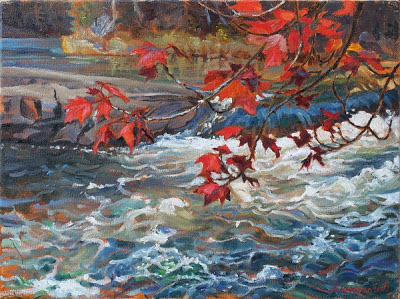Tundra Swans on Windy Lake Erie (oil on canvas 10 x 20 in.)
of Buffalo, New York, not so far away across the eastern tip of Lake Erie. I am pleased to have had time this winter to paint from my photos of that amazing day.
We only see these tundra-breeding Swans on Lake Erie, during their spring and fall migrations. The Swans that we see more frequently in southern Ontario are Trumpeter Swans, which are being reintroduced to the middle latitudes from which they were extirpated in the 18th Century, while European Mute Swans are being discouraged from breeding where they were once imported as lovely novelties. The reintroduction of Trumpeter Swans is proving more successful than that of Whooping Cranes, also a mid-latitude species hunted almost to extinction. While these Tundra Swans continue to breed in the north, the formerly northern Sandhill Cranes are spreading south through Ontario, and are now breeding regularly around Ottawa.
Fred and I had set out on this day with Cheryl Schonewille and Tim Seburn to look at the beach for shells and Fowler's Toad habitat. We walked east past shoreline cottages with a terrific wind at our backs, stronger than Superstorm Sandy had been here earlier in the month. Fred picked up scattered old Unionid shells, which were most dense at the cottage site of a 'professor from Wisconsin' who had planted native Dune Grass all over his beach. This was recently bulldozed away when he died and the place was put up for sale. We also saw native Phragmites reed in the lotline fencerow between his place and a neighbours. None of us took many notes because it was so hard to walk. On our way east we crossed a 'creek' flowing down to the beach. It was filled to the top with fallen Norway Maple leaves, but in its narrowest place, was 50 cm deep. This was where Fred and Cheryl got soakers, as all they could see was the watery mass of leaves. Lagging behind, I saw their adventure and found a safer place to cross.
We scooped up a sample of the old worn Zebra Mussel shells drifted in low dunes and caught in pockets like beach gravel. It was mixed Zebras and Quaggas. The Quaggas are the same genus, but tend to be a little larger and more oval in shape, not quite as pointed and hooked as the Zebra Mussels are. Native Unionids (fresh water mussels) are now considered extinct in Lake Erie due to the Zebra Mussel invasion. The distinctive thing that we found all along the shore was the drifted clots of algae like little sandy pancakes. We turned away from the beach there and returned along the road rather than going back upwind, since we wouldn't have been able to see anything with sand and tears in our eyes.
Here is a photo of our sample of drift. The few Crayfish claws look like the invasive Orconectes rusticus - Fred's currently reviewing a manuscript about the understudied invasions of the Great Lakes by introduced Crayfish of which Lake Erie has the greatest number. On checking through our database he finds that a sample of Unionid shells that he casually picked up from Lake Erie in 1972 is one of the few Lake Erie records of the lovely endangered mussel Villosa iris, which is called "The Rainbow" from the irridescence of its nacre. This is now regarded as extinct in the Great Lakes. Fred and Jennifer discovered a population in the Salmon River, north of Lake Ontario's Bay of Quinte in 1998, and we have checked on it occasionally since then. See Fred's record of one of our visits to the Salmon River to check on Villosa iris.
Dear patrons and supporters,
This painting is available for $800 to support our work on the 30 Years Later project, as we revisit places we studied over the past three decades. If you would like to purchase it, please contact me.
Aleta Karstad





An exciting painting!
ReplyDelete